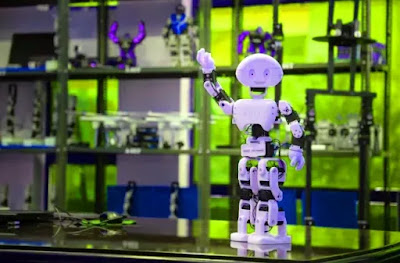Robot,
any automatically operated machine that replaces human effort, though it's
going to not resemble citizenry during appearance or perform functions in a
human like manner. By extension, robotics is that the engineering branch which
is handling the planning , construction, and operation of robots.
History of Robot :-
The
concept of artificial humans comes from recorded history, but the fashionable
term robot derives from the word robota (“forced labour”). The play’s robots
were manufactured humans, heartlessly exploited by factory owners until they
revolted and ultimately destroyed humanity. Whether they were biological, or
mechanical wasn't specified, but the mechanical alternative inspired
generations of inventors to create electrical humanoids.
The
word robotics first appeared in Isaac Asimov’s science-fiction story Runaround
(1942). Along with Asimov’s later robot stories, it set a replacement standard
of possibility about the matter of developing intelligent robots and thus the
technical and social problems which may result. Robots must have this qualities
:-
- Brawn- Strength
concerning physical payload that a robot can move.
- Bone - The
body of a robot relative to the work it does, this determines the dimensions
and weight of the robot in reference to its physical payload.
- Brain- Robotic
intelligence, what it can think and do independently, what proportion manual
interaction is required.
These
things are must important in any sort of robots to be work as a person's and
appear as if a person's .
Industrial robots already at work :-
Industrial
robots are increasingly utilized in a spread of industries and applications.
They come during a wide selection of models with the reach distance, payload
capacity and therefore the number of axes of travel (up to six) of their
jointed arm being the most common distinguishing characteristics,Because they
can be programmed to perform dangerous, dirty and/or repetitive tasks with
consistent and accuracy. Robots are used for assembling products, handling
dangerous materials, painting ,cutting and polishing, inspection of products.
Boosting Competitiveness :-
Robotics
would help U.S. companies deal with a shortage of labor and declining
productivity growth. Greater use of robots would improve competitiveness with
China, which is significantly bribe robotics as a part of its Made in China
2025 initiative. Robotics have the best impact in five sectors aerospace,
apparel, electronics, machine shops and automobiles that collectively represent
29 percent of U.S. manufacturing imports, 10 percent of labor costs and 36
percent of the nation’s trade imbalance.
With
the rapidly increasing power of the microprocessor and AI techniques, robots
have dramatically increased their potential as flexible automation tools. The
new surge of robotics is in applications demanding advanced intelligence.
Robotic technology is converting with a wide variety of different technologies
like machine vision, force sensing(touch), speech recognition and advanced
mechanics. This leads to exciting new levels of functionality for jobs that
were never before considered practical for robots.
Robot toys:-
Toy
robots, on the opposite hand, can entertain without performing tasks very
reliably, and mechanical varieties have existed for thousands of years. In the
1980s microprocessor-controlled toys appeared that would speak or move in
response to sounds or light. More advanced ones within the 1990s recognized
voices and words. In 1999 the Sony Corporation introduced a doglike robot named
AIBO, with twenty-four motors to activate its legs, head, and tail, two
microphones, and a color camera all coordinated by a powerful microprocessor.
The Future :-
Meanwhile,
other researchers still pursue various techniques to enable robots to succeed
in their surroundings and track their own movements. Many companies are
performing on consumer robots which will show their surroundings, recognize
common objects, and perform simple chores without expert custom installation.
Still about the year 2020 the method will have produced the primary broadly
competent “universal robots” with lizard like minds which will be programmed
for nearly any routine chore. With anticipated increases in computing power, by
2030 second-generation robots with trainable mouse like minds may become
possible. By 2040 computing power should make third-generation robots with
monkey like minds possible. By the center of the 21st century,
fourth-generation robots may exist with human like mental power ready to
abstract and generalize. Researchers hope that such machines will result from
melding powerful reasoning programs to third-generation machines.
Thanks For Reading Articles To read more Click Here And Follow our website.



















No comments:
Post a Comment